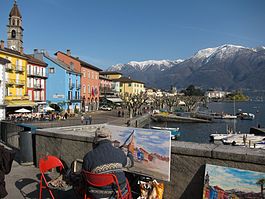Ascona
| Ascona | ||
|---|---|---|
 |
||
|
||
| Coordinates: 46°09′N 8°46′E / 46.150°N 8.767°ECoordinates: 46°09′N 8°46′E / 46.150°N 8.767°E | ||
| Country | Switzerland | |
| Canton | Ticino | |
| District | Locarno | |
| Government | ||
| • Mayor |
Sindaco Aldo Rampazzi |
|
| Area | ||
| • Total | 4.97 km2 (1.92 sq mi) | |
| Elevation | 196 m (643 ft) | |
| Population (Dec 2015) | ||
| • Total | 5,439 | |
| • Density | 1,100/km2 (2,800/sq mi) | |
| Postal code | 6612 | |
| SFOS number | 5091 | |
| Surrounded by | Brissago, Intragna, Locarno, Losone, Ronco sopra Ascona, San Nazzaro | |
| Website |
www SFSO statistics |
|
Ascona is a municipality in the district of Locarno in the canton of Ticino in Switzerland.
It is located on the shore of Lake Maggiore.
The town is a popular tourist destination, and holds a yearly jazz festival, the Ascona Jazz Festival.
The oldest archaeological finds in Ascona (at S. Materno and S. Michele) go back to the beginnings of Late Bronze Age. During the expansion of the cemetery in 1952, a necropolis was discovered at S. Materno, with 21 cremation urns were discovered. The urns were either simply buried or covered with a stone slab box. They contained cremated bones and, in some cases, bronze grave goods. Of particular interest are the bronze brooches, which are among the oldest that have been found so far in Switzerland. They also provide important evidence for the relationship of this area to the cultures of the Italian Peninsula. The grave goods have similarities with those from the final phase of the so-called Canegrate culture (named after a large necropolis in Milan). However, the materials used are those of the late Bronze Age north of the Alps. This allowed the cemetery to be dated to the period between the 12th and 10th Centuries BC and points out that Ascona took part in trade over the Alps through the Val Mesolcina and over Lake Maggiore with the Po Valley.
Similar objects were found by exploratory excavations in the late 1960s on the castle hill of San Michele. Both fine ceramics and coarse pottery were discovered, which suggests that this area was settled during the Late Bronze Age, even if there is no evidence to the municipal structures. Remains of walls and clay from the Balladrum hill are the only Iron Age objects found in the municipality. However, the exact age is unknown. The only item that has been conclusively identified is a single flagon from the 6th to 5th Century BC.
...
Wikipedia



